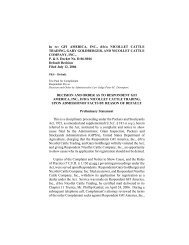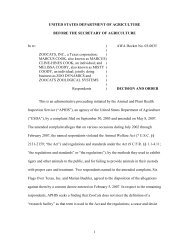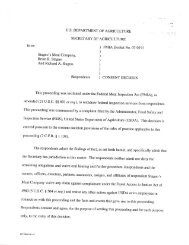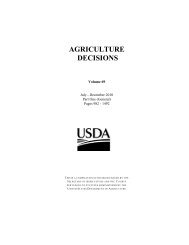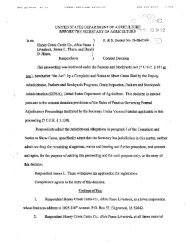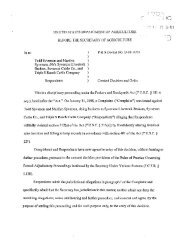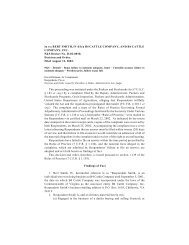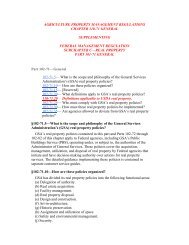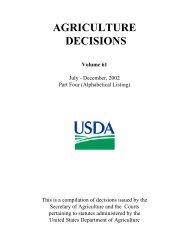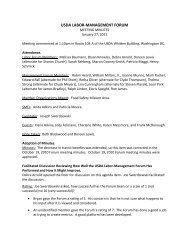Green Information Technology Strategic Plan - Departmental ...
Green Information Technology Strategic Plan - Departmental ...
Green Information Technology Strategic Plan - Departmental ...
Create successful ePaper yourself
Turn your PDF publications into a flip-book with our unique Google optimized e-Paper software.
8.6 FSA Modernization / MIDAS<br />
Background<br />
USDA-Farm Service Agency (FSA) provides several<br />
services and benefits to achieve the mission and goals of the<br />
Department. FSA delivers commodity, credit, conservation,<br />
disaster and emergency assistance programs that help<br />
improve the stability and strength of the agricultural<br />
economy. FSA also hosts and supports the delivery of the<br />
programs to assure the Nation of a stable food supply. The<br />
delivery of these services and benefits to customers (farmers,<br />
ranchers and cooperatives, etc.) is conducted through a<br />
National network of local offices throughout rural America.<br />
Typically, customers make an average of 4 trips annually to<br />
the local County Offices to conduct business with the Farm<br />
Service Agency. The purpose of these trips includes program<br />
application/signup; acreage reporting or certification;<br />
reconciliation of annual data or contract modifications; and<br />
inquiries about additional services and program benefits not<br />
accessible electronically.<br />
When the automated system for program delivery was<br />
developed, cellular telephone, voice over Internet protocol<br />
telephony, and the public Internet were non-existent. The<br />
basic operation of the automated system was designed with<br />
over 17 million lines of COBAL code on the mini computer.<br />
These mini-computers reside and routinely transmit<br />
information to a central mainframe to complete payment<br />
processing in every local county office to ensure the delivery<br />
of farm programs. The current system for delivery of farm<br />
program benefits and services is outdated, unstable, and<br />
lacks necessary support to continue the efficient and costeffective<br />
delivery of farm programs. The system limitations<br />
on the delivery of farm program benefits and services directly<br />
impacts the human activities performed by FSA customers<br />
which result in the environmental impacts related to the<br />
Agency’s carbon footprint measurement.<br />
Significant and numerous program requirements and the<br />
limited accessibility of the current legacy system for electronic<br />
submissions require frequent travel of our customers,<br />
and the utilization of enormous amounts of paper. FSA’s<br />
current systems hardware, mini-computers, and mainframe<br />
computers consume a large amount of electricity.<br />
FSA is currently pursuing significant modernization of<br />
the aging legacy system in order to address the challenges<br />
and opportunities in the rapidly changing legislative<br />
and technology environment. This project is known as<br />
Modernize and Innovate the Delivery of Agriculture Systems<br />
(MIDAS). The MIDAS project includes the acquisition of<br />
a Commercial-Off-The-Shelf (COTS) software product that<br />
Supporting Environmentally Responsible <strong>Technology</strong> at USDA<br />
will be configurable to meet the legislated mandates and to<br />
deliver farm program benefits and services to our customers.<br />
The COTS solution and proposed hardware architecture<br />
will be housed in an energy efficient data center.<br />
The uSDA-FSA MiDAS iT investment project will reduce<br />
the carbon dioxide emissions related to the delivery of farm<br />
program benefits associated with:<br />
n Hardware/software<br />
n Paper consumption<br />
n Travel to and from the local offices<br />
Current measurement:<br />
—Hardware and Infrastructure<br />
FSA’s legacy system currently operates using over 17 million<br />
lines of COBAL code on 2,555 mini computers located in<br />
approximately 2,277 FSA County Offices.<br />
Farm Service Agency (FSA) spends $3 million for<br />
maintenance iv costs related to the legacy systems. The<br />
estimated carbon emissions use to host and support the<br />
delivery of farm programs based on the current program<br />
activity is 6,680 tons annually. The topography of the<br />
original hardware was to locate a mini-computer in each<br />
county office when communications in the United States<br />
was mostly low speed over twisted pair. These physical<br />
county office locations were not designed with modern data<br />
center power and cooling efficiencies.<br />
Compared to the low-power, virtualized, equipment<br />
today; the FSA infrastructure is no longer an efficient<br />
host of applications. In addition, the system is no longer<br />
manufactured or supported in the United States. A new<br />
application hosted in a data center system will better support<br />
the producers in the United States and reduce the carbon<br />
footprint generated by the legacy systems and the equipment<br />
operating and maintained in the county offices.<br />
iv Data provided by OCIO<br />
73




